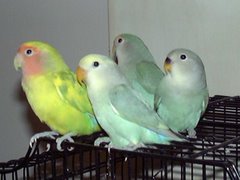Estimation of Uric Acid in Lovebirds Droppings
Lovebirds dropping contain both urine and feces. Isolated fresh dropping gives the best information and hence fresh dropping of birds was used for estimation of uric acid. In birds, uric acid is the normal product of nitrogen metabolism and is the catabolism of purine and protein in birds, whereas in mammals, it is only the end product of purine catabolism.
Synthesis of uric acid occurs in liver and kidney, the precursor being the xanthine and reaction is catalyzed by enzyme Xanthine oxidase. Uric acid is excreted mostly by the kidneys and partly by gut; Estimation of uric acid is an important step although serum uric acid is a better parameter for study, fresh isolated dropping obtained in the study birds randomly were subjected to uric acid analysis.
It is noteworthy to mention in this regard the blood concentration of uric acid is 2-15 mg/dl in domestic bird and 5-39 mg percent in female parakeet and 5.71 mg percent in male parakeet.
Need for Uric Acid Estimation
Synthesis of uric acid occurs in liver and kidney, the precursor being the xanthine and reaction is catalyzed by enzyme Xanthine oxidase. Uric acid is excreted mostly by the kidneys and partly by gut; Estimation of uric acid is an important step although serum uric acid is a better parameter for study, fresh isolated dropping obtained in the study birds randomly were subjected to uric acid analysis.
It is noteworthy to mention in this regard the blood concentration of uric acid is 2-15 mg/dl in domestic bird and 5-39 mg percent in female parakeet and 5.71 mg percent in male parakeet.
Need for Uric Acid Estimation
- To find out renal insufficiency
- To analyze the feed conversion ratio
- To find out deficiency of minerals and vitamins
- To analyze the water intake











 Free Ads For Bloggers
Free Ads For Bloggers

